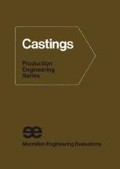Abstract
All metals and alloys can be liquefied by the application of heat and are thus able to flow, usually under the influence of gravity alone. When flow is required to proceed uphill, ie against the force of gravity, a head of metal is required or pressure must be applied — these techniques give rise to a range of casting processes. Virtually all metals and alloys, therefore, can be cast and this confers great versatility with respect to the processing of metallic materials. The progressive exploitation of the casting process has resulted in the growth and development of the cast metal industry and castings are used in almost all engineering products from motor cars typewriters and washing machines on the one hand, to ordnance, in all its various forms, ships, aircraft, both airframe and engine, and space age vehicle and rockets, on the other. The applications which have been satisfied by cast products are boundless. The process of casting is essentially, very simple, it is merely necessary to make the metal or alloy liquid, or at least semi solid, usually by elevating the temperature, alloying and refining may then be carried out and the metal is caused to flow into a cavity (which may be formed in a wide range of materials, metallic or non-metallic), at atmospheric or greater pressures. In practice, however, there are many factors and considerations which arise and these have a strong bearing in deciding the feasibility and economics of the process together with the quality and suitability of the product and such factors have to be accommodated or overcome in appropriate ways.
Preview
Unable to display preview. Download preview PDF.
Bibliography
Casting Properties of Metals and Alloys. A M Korol’kov New York, 1963 (Consultants’ Bureau), pp. 196. (English translation of the 1960 Russian edition published by Akademiya Nauk. Also, 1967, Russian edition).
Some Metallurgical Problems of Founding. V Kondic. Metallurgical Achievements (Selection of Papers Presented at the Birmingham Metallurgical Society’s Diamond Jubilee Session), edited by W. O Alexander. 1965 (Pergamon Press) pp. 137–152.
Metallurgical Principles of Founding. V. Kondic. London, 1968 (Edward Arnold (Publishers) Ltd.) pp. 286.
Steel Foundry Practice. P Bidulya (trans. A Troitsky). Moscow, undated, (Peace Publishers). See esp. Chapter II.
Fundamentals of Metal Casting. R A Flinn. Reading, Mass., 1963 (Addison-Wesley Publishing Co. Inc.) see especially Chapters 1–6.
Principles of Metal Casting. R W Heine, C R Loper and P C Rosenthal. New York, London, etc., 1967, 2nd. ed., (McGraw-Hill Book Co.) pp. 736.
The Solidification of Castings. R W Ruddle. Institute of Metals Monograph and Report Series No. 7 London, 1957, 2nd ed., (Institute of Metals), pp.406.
Principles of Solidification. BChalmers. New York, London, etc., 1964 (John Wiley & Sons Inc.) pp. 319.
Author information
Authors and Affiliations
Editor information
Copyright information
© 1971 Macmillan Publishers Limited
About this chapter
Cite this chapter
Beadle, J.D. (1971). Castability of Metals. In: Beadle, J.D. (eds) Castings. Production Engineering Series. Palgrave, London. https://doi.org/10.1007/978-1-349-01179-7_3
Download citation
DOI: https://doi.org/10.1007/978-1-349-01179-7_3
Publisher Name: Palgrave, London
Print ISBN: 978-1-349-01181-0
Online ISBN: 978-1-349-01179-7
eBook Packages: EngineeringEngineering (R0)

